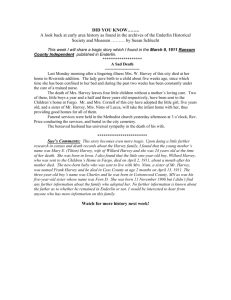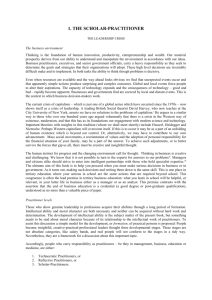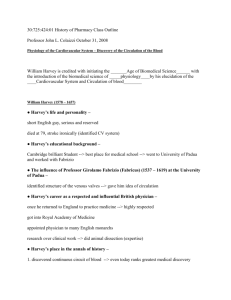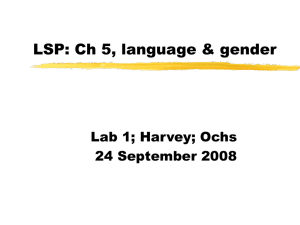shelby report - Planogramming Solutions, Inc
advertisement
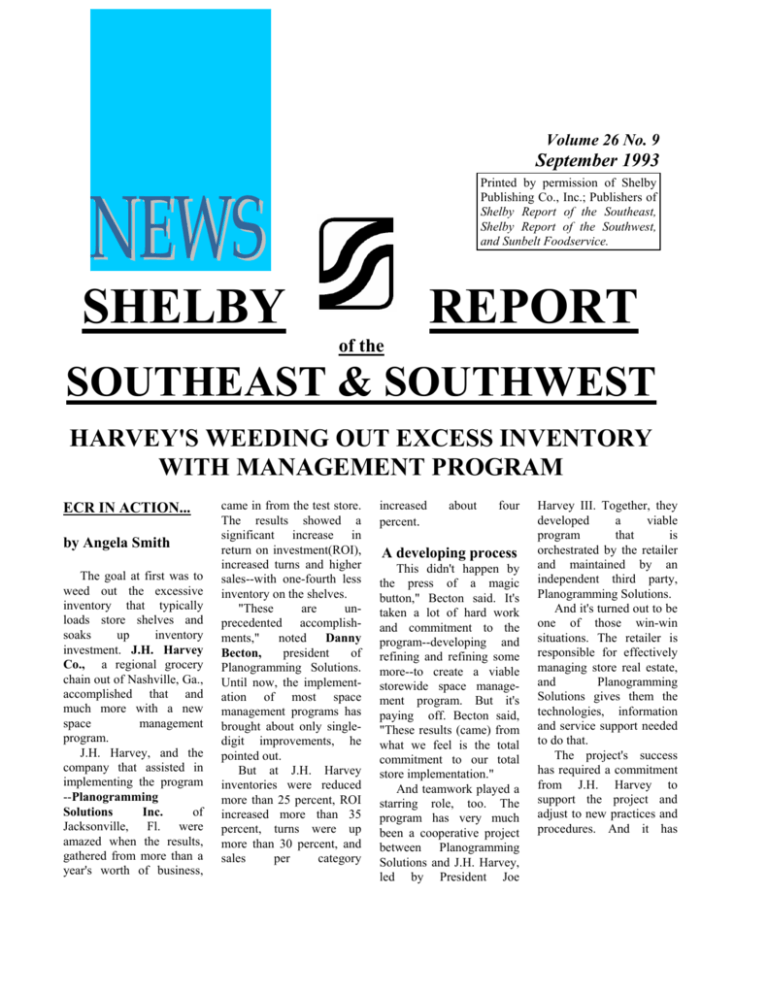
Volume 26 No. 9 September 1993 Printed by permission of Shelby Publishing Co., Inc.; Publishers of Shelby Report of the Southeast, Shelby Report of the Southwest, and Sunbelt Foodservice. SHELBY REPORT of the SOUTHEAST & SOUTHWEST HARVEY'S WEEDING OUT EXCESS INVENTORY WITH MANAGEMENT PROGRAM ECR IN ACTION... by Angela Smith The goal at first was to weed out the excessive inventory that typically loads store shelves and soaks up inventory investment. J.H. Harvey Co., a regional grocery chain out of Nashville, Ga., accomplished that and much more with a new space management program. J.H. Harvey, and the company that assisted in implementing the program --Planogramming Solutions Inc. of Jacksonville, Fl. were amazed when the results, gathered from more than a year's worth of business, came in from the test store. The results showed a significant increase in return on investment(ROI), increased turns and higher sales--with one-fourth less inventory on the shelves. "These are unprecedented accomplishments," noted Danny Becton, president of Planogramming Solutions. Until now, the implementation of most space management programs has brought about only singledigit improvements, he pointed out. But at J.H. Harvey inventories were reduced more than 25 percent, ROI increased more than 35 percent, turns were up more than 30 percent, and sales per category increased percent. about four A developing process This didn't happen by the press of a magic button," Becton said. It's taken a lot of hard work and commitment to the program--developing and refining and refining some more--to create a viable storewide space management program. But it's paying off. Becton said, "These results (came) from what we feel is the total commitment to our total store implementation." And teamwork played a starring role, too. The program has very much been a cooperative project between Planogramming Solutions and J.H. Harvey, led by President Joe Harvey III. Together, they developed a viable program that is orchestrated by the retailer and maintained by an independent third party, Planogramming Solutions. And it's turned out to be one of those win-win situations. The retailer is responsible for effectively managing store real estate, and Planogramming Solutions gives them the technologies, information and service support needed to do that. The project's success has required a commitment from J.H. Harvey to support the project and adjust to new practices and procedures. And it has September 1993 Shelby Report of the Southeast & Southwest required a commitment from ordering and numerous other the staff at Planogramming applications. Solutions to apply their ideas, program and Building blocks technologies in a manner A lot of time and energy that would work at store have gone into bringing the level. project to this point, and Currently, J.H. Harvey along the way the two has all its companies have Harvey's stores "This didn't encountered set by typical happen by planograms, and supermarket nine have been the press of "challenges," as optimized, or Al Smith, grocery a magic reset, for merchandiser for button." optimum J.H. Harvey, performance. refers to them. Interactive ---Danny Becton "Really, I don't communications at (the Planogramming look now flow glitches) as Solutions regularly between obstacles as much Planogramming Solutions as opportunities. Everything and the J.H. Harvey we've done was something merchandising staff. new and was taken in that Planogramming Solutions context." supplies Harvey's merchandIt started with a test store isers with the movement in Brunswick, Georgia. It data and reports needed to was one of the chain's make informed merchand- biggest stores, containing ising decisions, and J.H larger merchandising Harvey staff translate sections. merchandising changes and To begin with, Becton new item information back and his partner at to Planogramming Solutions Planogramming Solutions, so that necessary changes Bruce VanDerbeck went in can be worked into and "captured" the existing planograms. store set. That is, they And that's just the recorded the current layout, beginning. Becton refers to facings, stock, etc. From the newly-developed system that, they tracked movement as a foundation that can and gathered store sales easily be built upon. "In data. order to build a house, They made sure all items you've got to have a that were supposed to be in foundation. Merchandising each section were accounted at store level is that for and placed in the foundation, in my opinion," planogram. Then it was time he commented. to begin reworking the And J.H. Harvey has product mix. established a solid one. The standard rule of Based on the comprehensive thumb that attributes 80 system they've implemented, percent of sales to the top 20 the retailer could now easily percent of items was applied move into automatic and shelf space was reallocated, cutting the excess stock of slow-moving items to allow additional space for items that turn rapidly. "The goal is to have a planogram that, if nothing changes, will create the greatest potential for sales, turns and gross profit that it possibly can for the longest period of time," said Becton. That's optimization. A key factor to successful space management is being able to always have on the shelf those products that are going to sell the most. "We pinpoint which items are moving and which items are not," Becton said. "The ones that are not (moving), if you need them for variety, you're going to keep them, but you don't have to keep 100 day's supply on hand... We cut that back to a more reasonable amount," he noted. "In optimizing," Smith continued, "we know what we're going to move between the busiest time Page: 2 considerations on duplications and size variety. But the "big guns" are given their space first. Does that cripple supermarket variety? Not in this case. "Harvey still has a wide variety of grocery items," Smith said. The goal is to have the ideal product mix for each section. For J.H. Harvey, which operates a wide range of store sizes, sections are one of four sizes. The largest store may have a 12-foot section for a specific category, while others will have an eight-foot, six-foot or four-foot allocation for that category. The larger section is set with 100 percent distribution, with the product mix being scaled down to fit the smaller sections. Again, the top sellers go in first, variety is incorporated, and then based on available space, decisions are made about duplication and size variety. It doesn't make sense to "These are unprecedented accomplishments," noted Danny Becton, president of Planogramming Solutions. period and (know) that we're going to have that much product on the shelf. That's where the increase in sales is coming from." Where do they find room? They make room. The top 20 percent of items are worked into the planogram first and given adequate space to cover average movement between deliveries. Then comes allocation for slower movers and variety items, and then try to force into a four-foot section the same mix you have set out for a 12-foot section. The idea is to work in what will work best. The slowest moving size of one brand may be deleted, or the slowest brand in a certain size may go. "We'll still have every brand represented, but we won't carry every size of every brand in that small store," explained Smith. September 1993 Shelby Report of the Southeast & Southwest a typical supermarket challenge. J.H. Harvey came up with an innovative way to keep excessive shelf stock down to a minimum without leaving holes along the aisle. In places where the shelf holds more than is needed, the operators have filled "...inventories were up the extra space with foam packing to reduce reduced more than the depth of the shelf. 25 percent, ROI ''We had to develop some kind of straight increased more than line back,'' Becton said. 35 percent, turns ''Harvey took solid blocks of foam (spraywere up more than painted to match the 30 percent, and sales shelving) and built a false wall behind the per category product, ''explained increased about four Becton. The shelf holds appropriate, not percent." excessive, supply, since Supporting that idea, the the stock clerk cannot push Food Marketing Institute stock past that wall. It was (FMI) has published a study one of those ingeniously showing that supermarkets simple solutions. move less than a case a month of 40 percent of all No small task items, and many move much Once a section is set for more slowly. "Those are the optimum performance, items that create so much there's the challenge of stress on the category. regularly maintaining the They've got to be there for variety, and the sales you get set. It's an ongoing process, from them are important not a one-shot deal. ''One of the pitfalls that sales. They attract different causes retailers to not types of customers and they succeed in (space have big gross profits,'' management) is that they acknowledged Becton. tremendously underestimate But enough is enough. If you pack out a shelf with a the impact of changes supermarket slow mover, especially when (within sections), and (they usually it's given two facings, you lack) the resources you have easily wind up storing a to have to keep up with the years' worth of inventory on changes,'' Becton said. the shelf. "Tell me where the Each day in the grocery profitability is in that, "he business brings new items, said. deletions, removals, Grocers don't want stale packaging changes. And product supply, but neither each change affects the do they want sparselyalignment of the category. stocked shelves. Therein lies To illustrate the magnitude Only what's needed That can sometimes be a hard pill for manufacturers to swallow. But it's effective, as Smith and Becton pointed out. Forcing too much product onto the shelves ties up space and inventory investment. Page: 3 of the changes, Becton noted It happens on a monthly that grocers process cycle, and the manufacturer anywhere from 200-250 new knows that he has to get his items each month, along item in before the cutoff. with 100-150 items that are Otherwise, the change or deleted or removed. The introduction will have to numbers become even more wait for a month. Merchandising decisions astounding considering that each category is set are handled at the corporate the differently for each store level and it's responsibility of the format. "Over 525 different manufacturer to negotiate planograms have to be the space he's looking for . items and maintained for the grocery, New HBC and perishables merchandising changes are departments. About 225 of worked into the planogram, those change on average and the planograms are sent each month within a chain to the stores for monthly set like Harvey,'' Becton said. maintenance. That becomes "Obviously, this is no small the plan for the next 30 days. There are no planogram task. But this is the foundation of the changes made during store sets, notes Smith, who heads technology.'' J.H. Harvey Using its proprietary the computer system, merchandising team. The Planogramming Solutions planogram is set as outlined. has established a program If a manufacturer's rep "has that incorporates these a problem or disagrees with changes in an organized, "The goal is to have a manageable manner. The program is planogram that, if supported by nothing changes, will interactive communication with create the greatest the retailer and potential for sales, tailored retail service. Much more is turns and gross involved than just profits that it possibly drawing out planogram pictures. can for the longest Actually, it's more period of time, said like setting up a new way of doing Becton. That's business. Structure has Advantages optimization." J.H. Harvey has now instituted a very disciplined cycle for the merchandising process. Manufacturers are given a cutoff date for new item presentations and merchandising adjustments. (the arrangement), they come see me and we look over it objectively. If they have a good, valid reason we'll change it. It'll go out in the next set of planograms. But we don't change anything at store level," Smith stressed. September 1993 Smith encourages input and participation from all manufacturer sales personnel, as they are the experts on the particular products they represent. Smith wants them to come in and share ideas so they can together explore the best merchandising plan for the product. But the reps have to work within the process or it can throw a wrench into the works. Planograms are maintained to such precision that J.H. Harvey is able to print shelf tags in sequence by the planogram. But to do that, everything must be in order. Order--a carefullydeveloped planogram-has a number of benefits, including shorter time periods spent on store sets, and immediate identification of errors or variations from the planogram after the section is set. Shelby Report of the Southeast & Southwest In this manner, the category is continually evolving under an organized plan. The store level set can be monitored and analyzed consistently. One of the benefits that had evolved from this process is, surprisingly enough, an ability to get new items onto the shelves more quickly than before. As soon as a new item is approved, space allocation is figured into the monthly planogram cycle. A spot on the shelf is available and waiting when the product is delivered to the store. The new product goes right onto the shelf, rather than into a backroom where it would sit until space could be cleared. Also, because the new item is being incorporated into an organized planogram, it can be positioned for the best chance at success. ''The item always goes where it belongs and always gets its facings... It's going to get a fair test here, ''said Smith. ''New items really get a chance to show what they'll do. ''J.H. Harvey tracks new Page: 4 Planogramming Solutions so they can make better merchandising decisions; controls that eliminate or catch inefficiencies, etc. It's definitely a big step forward for J.H. Harvey. "Based on the comprehensive system they've implemented, the retailer could now easily move into automatic ordering and numerous other applications." items for six months. A priority for J.H. Harvey in developing this program has been to get 100 percent distribution for new items. That has been accomplished. There are many side benefits that have evolved from implementing this new space management program, too: detailed feedback supplied to J.H. Harvey merchandisers from For Planogramming Solutions, the space management program with J.H. Harvey has also had its share of benefits. The company recently signed a contract with its second account and is starting to work a project with a specialty grocer, Fresh Fields Markets, Rockville, Md. Shelby Report of the Southeast & Southwest September 1993 Page: 5 PUBLISHER... ECR MEANS GETTING BACK TO BASICS FROM THE E CR. What a concept. You buy the goods that the people want and put them on your store shelves. is that not brilliant? You've got to kick yourself around the office for not thinking of it yourself. Well, it seems people are confused. We had a call the other day from someone "hungry for information" on ECR. He was "looking for concrete information" on why and what the retailer is supposed to be doing. Efficient Consumer Response. Think about what it means. You respond to the shopper not the manufacturer. You tell the manufacturer, in essence, what the people are buying, what you need from him. He in turn presents you with his consumer studies, with alternative products that may suit your shoppers' needs, etc. The point is, you two are discussing the consumer, not what kind of deal you can make on a couple of cases of pole beans. Forgetting how complicated this discussion on ECR could get, the main thing to do is concentrate on how simple it is. It is a reversal of a process that, like many things American, has gotten out of hand. The art of the deal has replaced the essence of the deal--dealing for the sake of dealing. Dealing takes place in a vacuum, far from the madding crowd. ECR is just a logical effort to rein in a runaway truck full of deals, to come back from la-la land and get down to business. Walmart is already doing it and so are many others. There is no set method for streamlining the process of buying and selling. The idea is to get back to basics. Buying and selling to customers. To say to yourself, "We will make the decisions on what is best for our stores." This is the approach taken by regional chain J.H. Harvey, based in south Georgia, whose story you will find starting on page one. This is one of many companies whose leaders see the logic of building back into the system efficiencies they lave lost over the years. Not all retailers want to assume power in their relationships with suppliers, said Daniel A. Becton, who has helped implement the new program at J.H. Harvey. "Some still leave the planogramming process 100 percent in the hands of the manufacturer." That may be necessary or even preferable for some, and we can't argue with their circumstances. But for others it is time to take the initiative and implement some changes. That's where the "response" comes in. In our rugged competitive environment, you've got to respond efficiently to the consumer. It may be easier for regional chains-- which have clout in their areas but at the same time flexibility within their organizations -- to get the ball rolling than for huge chains that are spread all over the map or small independents that have minimal personnel and financial backing. ECR means taking control of store space, it means working from the bottom level (the store) towards the top (the manufacturer) instead of the other way around. Initially there will be some sort of cost involved, whether that means hiring more people to manage space or expanding jobs that previously were isolated from the process. It could mean losing out on some deals. But proponents say in the long run everyone wins when you start making decisions based on what's selling. They say the investment is worth it. The rallying cry we're hearing, for those who have ears to hear, is "Learn to merchandise your stores!" Truly a magnificent concept. -------Gary G. Shelby


